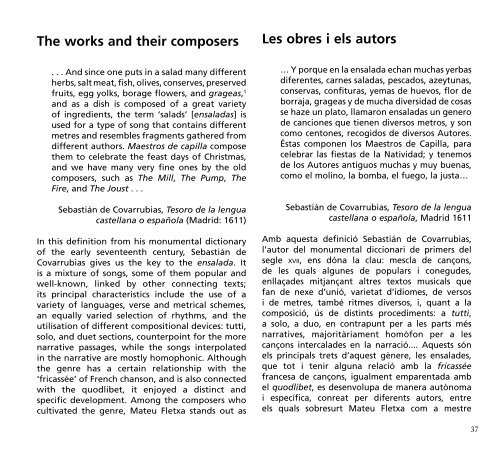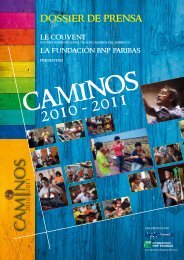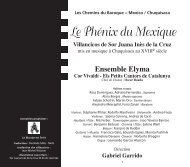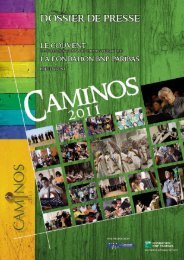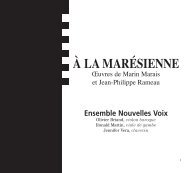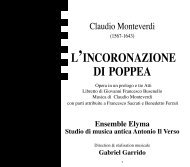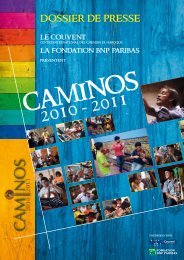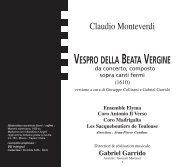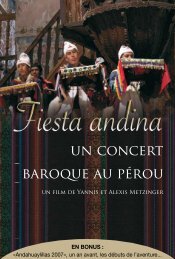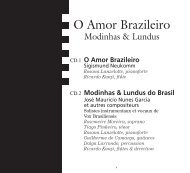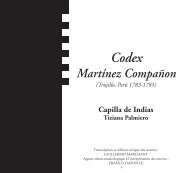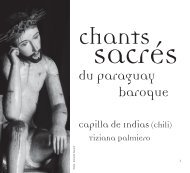Create successful ePaper yourself
Turn your PDF publications into a flip-book with our unique Google optimized e-Paper software.
the works and their composers<br />
. . . And since one puts in a salad many different<br />
herbs, salt meat, fish, olives, conserves, preserved<br />
fruits, egg yolks, borage flowers, and grageas, 1<br />
and as a dish is composed of a great variety<br />
of ingredients, the term ‘salads’ [ensaladas] is<br />
used for a type of song that contains different<br />
metres and resembles fragments gathered from<br />
different authors. Maestros de capilla compose<br />
them to celebrate the feast days of Christmas,<br />
and we have many very fine ones by the old<br />
composers, such as The Mill, The Pump, The<br />
Fire, and The Joust . . .<br />
Sebastián de Covarrubias, Tesoro de la lengua<br />
castellana o española (Madrid: 1611)<br />
In this definition from his monumental dictionary<br />
of the early seventeenth century, Sebastián de<br />
Covarrubias gives us the key to the ensalada. It<br />
is a mixture of songs, some of them popular and<br />
well-known, linked by other connecting texts;<br />
its principal characteristics include the use of a<br />
variety of languages, verse and metrical schemes,<br />
an equally varied selection of rhythms, and the<br />
utilisation of different compositional devices: tutti,<br />
solo, and duet sections, counterpoint for the more<br />
narrative passages, while the songs interpolated<br />
in the narrative are mostly homophonic. Although<br />
the genre has a certain relationship with the<br />
‘fricassée’ of French chanson, and is also connected<br />
with the quodlibet, it enjoyed a distinct and<br />
specific development. Among the composers who<br />
cultivated the genre, Mateu Fletxa stands out as<br />
Les obres i els autors<br />
… Y porque en la ensalada echan muchas yerbas<br />
diferentes, carnes saladas, pescados, azeytunas,<br />
conservas, confituras, yemas de huevos, flor de<br />
borraja, grageas y de mucha diversidad de cosas<br />
se haze un plato, llamaron ensaladas un genero<br />
de canciones que tienen diversos metros, y son<br />
como centones, recogidos de diversos Autores.<br />
Éstas componen los Maestros de Capilla, para<br />
celebrar las fiestas de la Natividad; y tenemos<br />
de los Autores antiguos muchas y muy buenas,<br />
como el molino, la bomba, el fuego, la justa…<br />
Sebastián de Covarrubias, Tesoro de la lengua<br />
castellana o española, Madrid 1611<br />
Amb aquesta definició Sebastián de Covarrubias,<br />
l’autor del monumental diccionari de primers del<br />
segle x v i i, ens dóna la clau: mescla de cançons,<br />
de les quals algunes de populars i conegudes,<br />
enllaçades mitjançant altres textos musicals que<br />
fan de nexe d’unió, varietat d’idiomes, de versos<br />
i de metres, també ritmes diversos, i, quant a la<br />
composició, ús de distints procediments: a tutti,<br />
a solo, a duo, en contrapunt per a les parts més<br />
narratives, majoritàriament homòfon per a les<br />
cançons intercalades en la narració.... Aquests són<br />
els principals trets d’aquest gènere, les ensalades,<br />
que tot i tenir alguna relació amb la fricassée<br />
francesa de cançons, igualment emparentada amb<br />
el quodlibet, es desenvolupa de manera autònoma<br />
i específica, conreat per diferents autors, entre<br />
els quals sobresurt Mateu Fletxa com a mestre<br />
37


